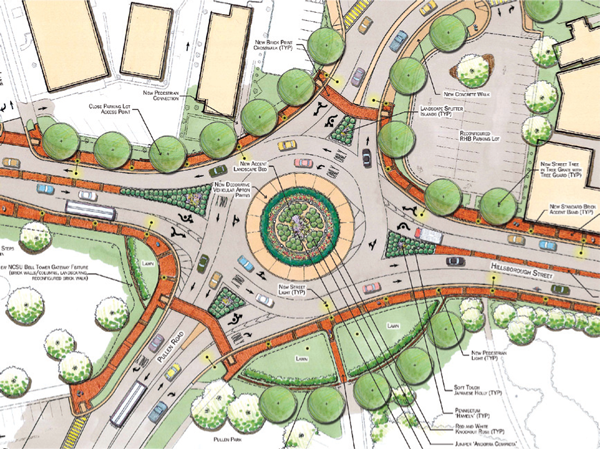Rotary Intersection Analysis and Design - Transportation Engineering

Description
Designing the geometry of a roundabout involves choosing between trade-offs of safety and capacity. Roundabouts operate most safely when their geometry forces traffic to enter and circulate at slow speeds. Horizontal curvature and narrow pavement widths are used to produce this reduced-speed environment. Conversely, the capacity of roundabouts is negatively affected by these low-speed design elements. As the widths and radii of entry and circulatory roadways are reduced, so also the capacity of the roundabout is reduced. Furthermore, many of the geometric parameters are governed by the maneuvering requirements of the largest vehicles expected to travel through the intersection. Thus, designing a roundabout is a process of determining the optimal balance between safety provisions, operational performance, and large vehicle accommodation.
While the basic form and features of roundabouts are uniform regardless of their location, many of the design techniques and parameters are different, depending on the speed environment and desired capacity at individual sites. In rural environments where approach speeds are high and bicycle and pedestrian use may be minimal, the design objectives are significantly different from roundabouts in urban environments where bicycle and pedestrian safety are a primary concern. Additionally, many of the design techniques are substantially different for single-lane roundabouts than for roundabouts with multiple entry lanes.
-
In transportation engineering, rotary intersections or roundabouts are circular intersections where traffic flows around a central island. Roundabouts are designed to improve safety, reduce congestion, and enhance traffic flow efficiency. The analysis and design of roundabouts involve various factors, including geometric design, traffic analysis, safety considerations, and pedestrian and cyclist facilities.
- Geometric design: Geometric design elements of roundabouts include:
- Inscribed circle diameter: Determines the size of the roundabout and is influenced by the design vehicle, traffic volume, and roadway classification.
- Central island diameter: Affects the deflection of vehicles entering the roundabout and should be sized to accommodate landscaping or other features.
- Entry and exit widths: Based on the number and width of lanes, as well as the design vehicle.
- Entry and exit angles: Affects vehicle speeds and the ease of merging and diverging.
- Approach and departure geometry: Ensures smooth vehicle transition from approach roadways to the roundabout.
- Circulatory roadway width: Influenced by the number of circulating lanes and design vehicle.
-
Traffic analysis: Traffic analysis involves estimating current and future traffic volumes, determining appropriate lane configurations, and assessing the capacity and level of service (LOS) of the roundabout. Analysis tools, such as the Highway Capacity Manual (HCM) and specialized software like Synchro, VISSIM, or SIDRA, can help model traffic performance under various design scenarios.
-
Safety considerations: Roundabouts generally enhance safety by reducing the number of conflict points and encouraging lower speeds. Some safety considerations include:
- Sight distance: Ensuring adequate sight distances for entering, circulating, and exiting vehicles.
- Vehicle deflection: Designing the roundabout to encourage appropriate entry and circulating speeds.
- Signing and pavement markings: Providing clear guidance for motorists, pedestrians, and cyclists.
- Pedestrian and cyclist facilities: Accommodating pedestrians and cyclists is essential for a well-designed roundabout. This can include:
- Crosswalks: Providing marked crosswalks at appropriate locations, usually set back from the circulatory roadway.
- Sidewalks or paths: Connecting pedestrian facilities around the roundabout.
- Ramps and refuge islands: Ensuring accessibility for all users and providing safe waiting areas for crossing.
- Bicycle lanes or shared-use paths: Designing facilities for cyclists to navigate the roundabout safely and efficiently.
The analysis and design of roundabouts require a comprehensive understanding of traffic engineering principles, roadway geometry, and safety considerations. Detailed guidance can be found in design manuals and guidelines, such as the FHWA's Roundabouts: An Informational Guide or the AASHTO's Green Book. Collaboration with experienced transportation engineers and planners is essential for the successful implementation of roundabouts in a transportation network.
Calculation Preview
Full download access to any calculation is available to users with a paid or awarded subscription (XLC Pro).
Subscriptions are free to contributors to the site, alternatively they can be purchased.
Click here for information on subscriptions.

